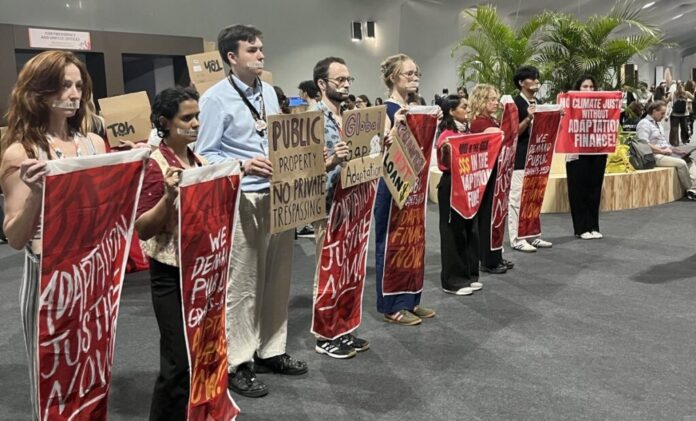We’re halfway through COP30 in Belém, the gateway to the Amazon in Brazil. As we outlined a week ago, adaptation is a key deliverable from this COP, and there has been meaningful progress – but there is still a long way to go to achieve a balanced and ambitious adaptation package capable of delivering for climate-vulnerable communities.
The big prize from this COP
What’s needed from COP30 is a coherent adaptation package that brings together the indicators for the Global Goal on Adaptation (GGA), progress on National Adaptation Plans (NAPs), a credible new commitment on adaptation finance, and agreement on the Baku Adaptation Roadmap (BAR), which defines our way forward on adaptation. These pieces must align; countries need clear metrics, adequate finance, and plans adapted to national and local circumstances to accelerate adaptation action. Below, we’ll focus on the GGA and on adaptation finance.
Faltering on the GGA indicators
The Global Goal on Adaptation, first set out in the Paris Agreement ten years ago, was meant to provide a way of tracking progress on adaptation and uniting behind a common call to action, much like the 1.5°C temperature goal has done for mitigation. But developing adaptation indicators has proven technically and politically challenging. Adaptation is inherently local, so global indicators will never be able to capture the full breadth of global adaptation action. The current question is whether the proposed set of 100 indicators is ‘good enough’ to move forward and refine in due course, or whether more negotiation is still needed beyond Belém.
Political disagreements on the indicator package centre on ‘Means of Implementation’ indicators, essentially around what sources of finance should count: domestic, private, or only international public finance? Developing countries argue that only public finance should be tracked under the GGA indicators. To resolve this blockage, the Brazilian Presidency has appointed a ministerial pair from Germany and the Gambia to work with countries and seek a compromise by Tuesday.
More encouraging signals on a new adaptation finance commitment
Crucially, the viability of a GGA outcome will also depend on what happens on a potential new commitment on adaptation finance, and how ambitious this new goal would be. Developing countries have been clear that the GGA cannot stand on its own without a corresponding commitment on finance, as many of them grapple with data collection and technical capacity challenges.
In the lead-up to COP, momentum accelerated toward a new adaptation finance commitment, with strong messages from coalitions such as the Climate Vulnerable Forum, and from the COP Presidency. At COP itself, this momentum has solidified, with developing countries uniting behind a call for $120bn a year in adaptation finance by 2030. While nothing is agreed yet, the united push is significant.
Adaptation is not optional. Adaptation finance is not charity.
Evans Njewa, Chair of the LDC Group on Climate Change, at a press conference on the first day of COP30
An emerging discussion at COP is whether a new adaptation finance commitment could be framed as a percentage of the New Collective Quantified Goal (NCQG) of $300 billion, agreed last year. This approach would tie adaptation finance to a broad aggregate that is likely to include a mix of flows, including outflows from Multilateral Development Banks (MDBs) and mobilized private finance. These resources are often difficult to steer towards locally-led adaptation priorities and raise questions about how such a commitment would ensure predictability, accessibility, and concessionality for the communities that need this support the most.
This is precisely why embedding strong safeguards on the quality of adaptation finance is critical. As the latest in our ‘Fair Shares’ series of reports with ODI shows, this is something that varies significantly across all providers of climate finance, and improvement in this area is a must. Clear requirements on grant-based and highly concessional public finance, particularly for Least Developed Countries and Small Island Developing States, will be essential, so as not to exacerbate debt. Without this, a new goal would risk diluting the integrity of adaptation finance, making it harder for vulnerable countries and communities to access resources that truly meet their needs.
In addition, our research has shown that relying too heavily on private finance to fill the $350 billion adaptation finance gap – or any emerging adaptation finance goal – is unrealistic. This perspective is now gaining traction, and was reflected in the highly influential report from the Independent High Level Expert Group.

What now?
Overall, COP30 has been constructive so far. The Brazilian Presidency has shown strong diplomatic leadership, and Parties generally express confidence in its ability to steer a balanced outcome. Yet, it is still not clear how four extra and contentious items proposed for the agenda by Parties – including the provision of finance by developed countries – will be resolved. The Presidency has held consultations, but it’s still unclear exactly how these issues will be addressed as ministers arrive for next week’s negotiations.
As the talks intensify, the Alliance team will continue pushing for an ambitious adaptation package, one where progress on the GGA is not left hanging without a robust, accessible, and high-quality finance commitment to match it.
Take a look at our event page for details on where you can find us at COP events, and the evidence we’re sharing. You can also view the event page for our side event in collaboration with ODI.
